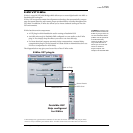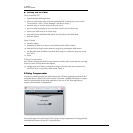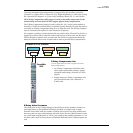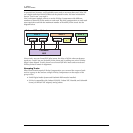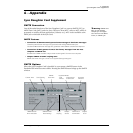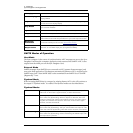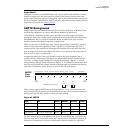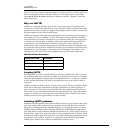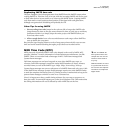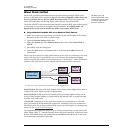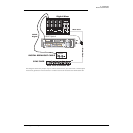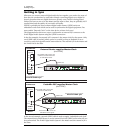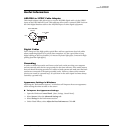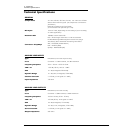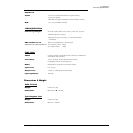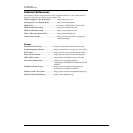
6 - Appendix
MIDI Time Code (MTC)
E-MU Digital Audio System 75
Duplicating SMPTE time code
The Sync Daughter Card always generates clean SMPTE from the SMPTE output when
reading SMPTE in. This time code is in sync with the incoming SMPTE and can be used
to feed other devices in your studio or to clean up old SMPTE tracks. Copying SMPTE
code from track to track produces deterioration of the signal with each generation,
although one generation of dubbing will probably be OK.
Other Tips for using SMPTE
1. Use ascending time code. Jumps in the code are OK as long as the SMPTE code
jumps forward in time as the tape moves forward in time. A good way to avoid any
problems with this is to simply stripe the entire project with SMPTE before you
record any other tracks.
2. Allow enough leader. Leave a few seconds between each song to allow SMPTE to
sync up before the song starts.
Keep written logs. Keeping written records of song start points and edit cues can save
time and avoid wasteful searching through a project that was recorded earlier.
MIDI Time Code (MTC)
MTC and SMPTE do
NOT synchronize at the
sample rate and are not
locked to word clock in
any way.
SMPTE and MTC are used
to synchronize music but
do not have the required
resolution to sample-lock
digital audio.
MIDI time code is basically SMPTE time code adapted to the world of MIDI. MTC
specifies “absolute” location information in hours:minutes:seconds:frames, just like
SMPTE. There are two main kinds of messages in MTC: Full-frame messages and
Quarter-frame messages.
Full-frame messages are ten bytes long and are sent when SMPTE start, stops, or
relocates. Full-frame messages contain the entire SMPTE number of, hours, minutes,
seconds, frames, as well as the SMPTE type: 24fps, 25fps, 30 non-drop, 30 drop.
Quarter-frame messages are sent at each quarter of a SMPTE frame and only carry 1/8th
of the SMPTE time message. Quarter-frame messages require two entire SMPTE frames
to send the complete time stamp (h:m:s:f). Timing accuracy is maintained as long as the
quarter-frame messages continue to come in at a constant rate.
Since it is important to have a stable timing reference for your song or sequence, we
have given MTC its own MIDI output port on the Sync Daughter Card. This ensures that
the timing information will not be affected by other MIDI data on the line.



